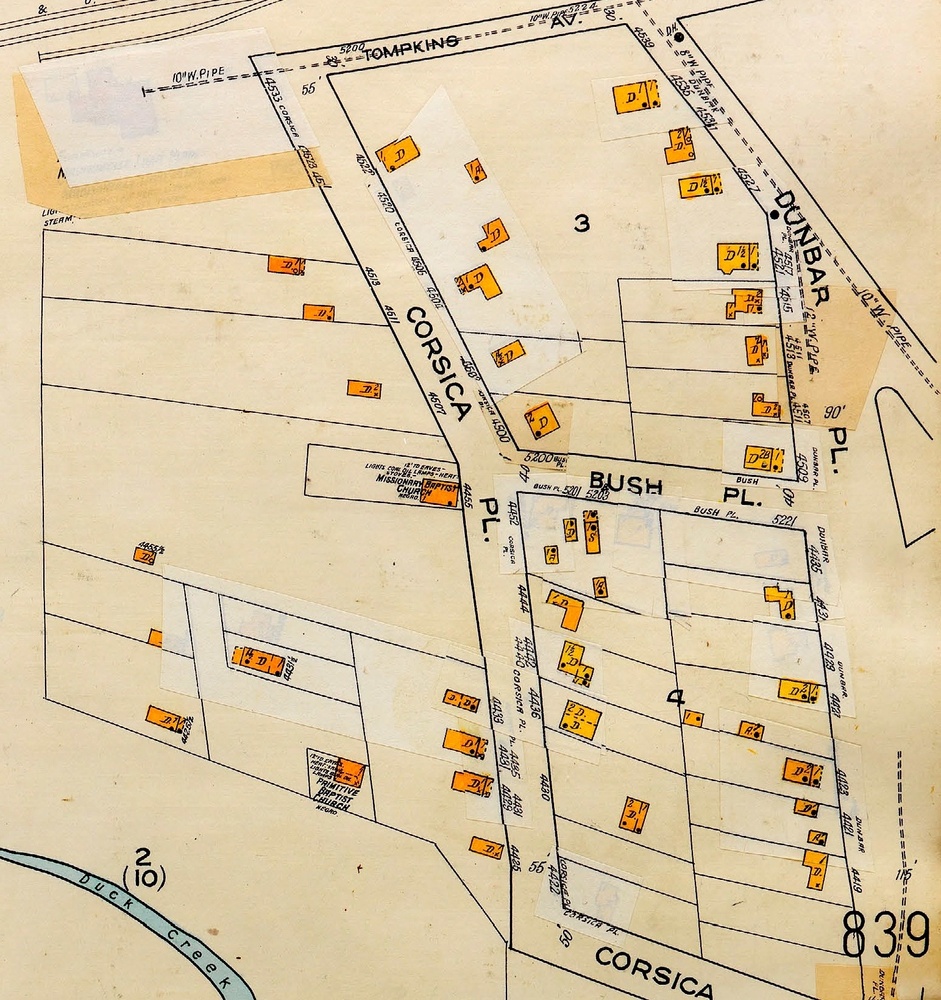The Dunbar Community
A lost African American community

The Dunbar neighborhood – also known as Corsica Hollow – was an African American community on the west edge of Madisonville. In the 1990’s, the City of Cincinnati used the right of eminent domain to seize all of the land, tear down the houses, and re-zone the area for industrial use.
Land in this area was originally available because in 1886, a wagon-maker named Mahon P. Leonard (who was white) subdivided his 10-acre tract near Duck Creek and began selling the lots to African-Americans.
Most of the settlers in Dunbar were from the South, and some had been born there prior to Emancipation, including Harriet Deatherage, Elihu and Elizabeth Parks, Simeon Bush, and Marion Rollins. According to a 2006 article in the Madisonville Review, “These families built single dwelling homes by themselves. The Dunbar community did not have running water, sewage, nor electricity. They survived with outhouses, coal oil lamps, and wood burning stoves.”
At its peak in the early-mid-20th century, Dunbar had perhaps 50 houses plus two churches, a small grocery, a hair salon, and a population of 170 or so.
The two churches were both Baptist. The smaller was St. Luke’s, a Primitive Baptist (sometimes called “anti-missionary”) congregation. The larger was the New Mission Missionary Baptist Church, founded in 1907. The church was organized at the home of Nannie Underwood. The organizers included Ben Ballew, Thomas Duett, and Grandison Embry, and these three became the first deacons. Land for a church building was donated by James Murphy. The original building was furnished with crude benches and a coal stove, and it was lit with coal oil lanterns.
The New Mission Missionary Baptist Church still exists. They moved to a new building in 1963, and then a newer one, on Ravenna Street, in 1981.
Because Corsica Hollow was a Black neighborhood, the residents often faced institutional racism. For example: there was no water line in Corsica Place, the major residential street. The Village of Madisonville had built a water pumping station in 1892, and they put mains in many streets, but not that one. In 1905, Madisonville installed a public hydrant nearby and told the residents that they could carry water from the hydrant to their homes.
Cordelia Rollins and her husband Marion built a house on Corsica Place in 1906. Mrs. Rollins got tired of carrying water 300 feet to her house, so after Madisonville was annexed by the City of Cincinnati in 1910, Ms. Rollins went to the city and asked for a water main in her street. The city refused. So Ms. Rollins got a petition signed by all of her neighbors. And the city still refused.
Cordelia Rollins waged a decades-long battle to get a water main installed in Corsica Place. The City of Cincinnati finally gave in, but they told Mrs. Rollins that she personally would be assessed a $100 fee to get city water. She agreed. The main was completed in 1940, nearly thirty years after she requested it. Mrs. Rollins died in 1942. Her son Wiley paid the final installment on the water main assessment the following year, 1943.
Dunbar no longer exists. During the early 1970’s, the construction of Red Bank Expressway clipped the edge of Dunbar, taking nine or ten houses. The remainder of the community was cut off from Duck Creek and hemmed in between the new expressway and old Red Bank Road.
Decades of institutional racism had afflicted the community. Inadequate city services, red-lining by banks, disparities in pay for black workers, and disparities and policing and sentencing – all of these had taken their toll. The community looked run-down, and it came to be seen by city planners as an eyesore.
In 1992, the City of Cincinnati purchased the remaining 40 houses by right of eminent domain, without giving the residents any choice. The City helped relocate the last residents, tore down the buildings, and re-zoned the property. The old church building of the New Mission Church was demolished in 1995, ending the era of Corsica Hollow.
Images
